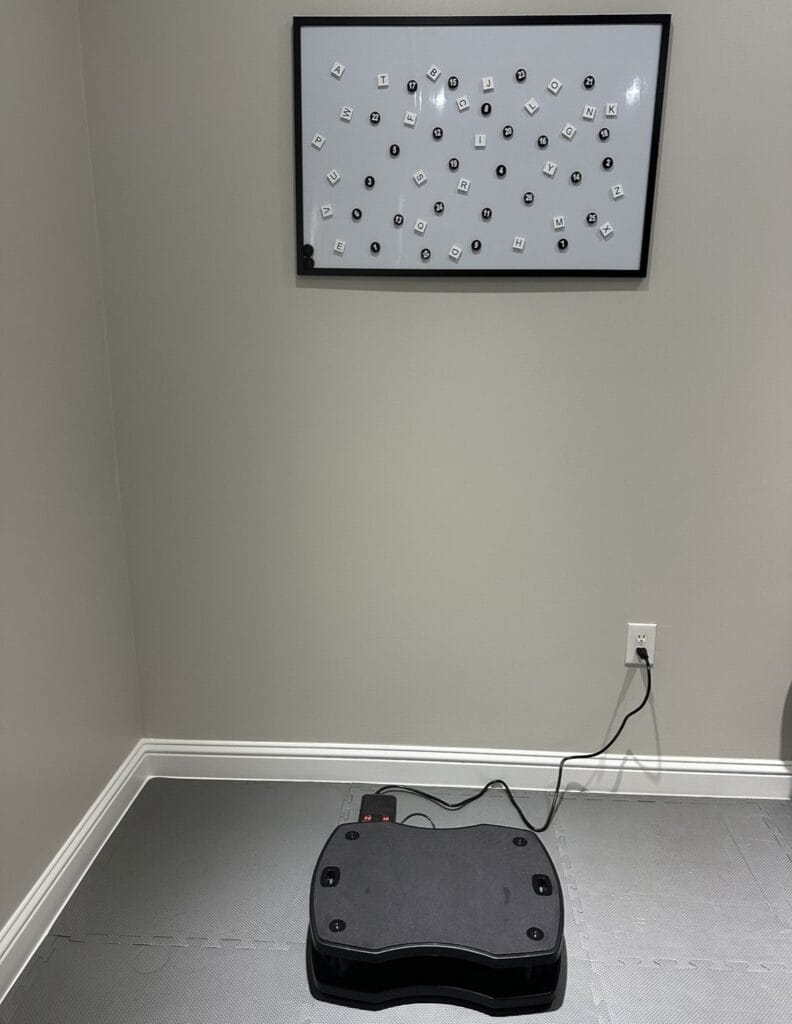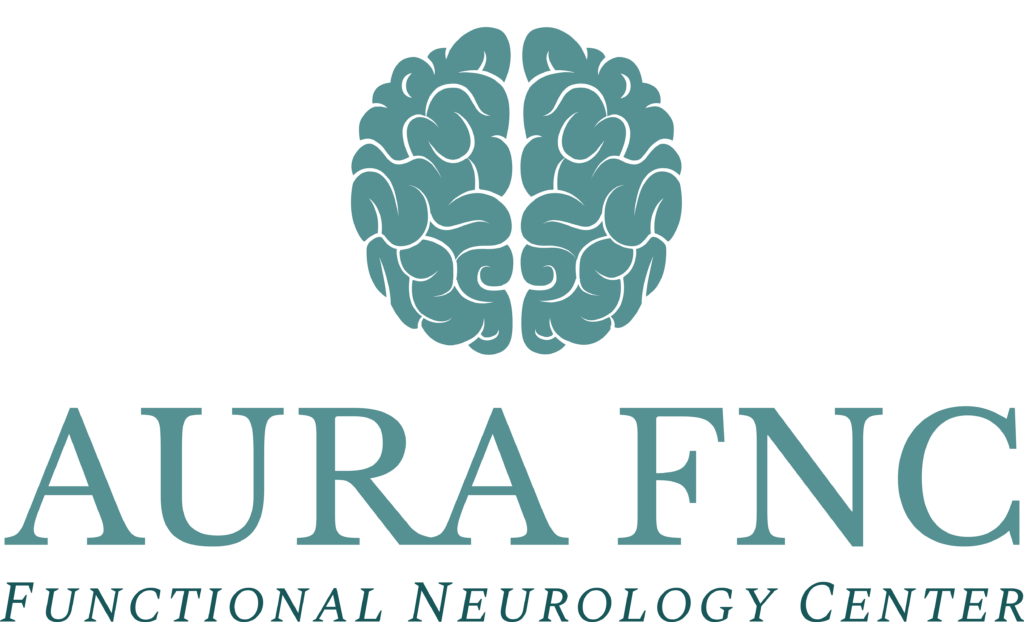Vibration Therapy
What is Vibration Therapy?
Vibration therapy is a form of physical therapy that uses mechanical vibrations to treat a variety of health issues. The therapy involves applying controlled vibrations to the body, either locally or throughout the entire body, to stimulate muscles and tissues. At Aura Functional Neurology Center (Aura FNC) we offer vibration therapy and use a vibration plate while doing neurological exercises to stimulate certain areas of the brain that need improvement.
The use of vibration therapy dates back to ancient civilizations, where it was believed to have healing properties. In the 1800s, physicians began using vibration therapy to help with muscular disorders and circulation problems. In the 1960s, Russian cosmonauts used vibration therapy to combat the effects of being in zero gravity for extended periods of time.
Today, vibration therapy is used in a variety of settings, including functional neurology offices, physical therapy clinics, sports medicine facilities, and fitness centers. It is often used to improve muscle strength and flexibility, increase blood flow, and reduce pain and inflammation.

Dr. Diana Tyler DC, DACNB
Founder of Aura FNC with experience using vibration therapy with her patients at the Aura FNC office located in Cumming, Georgia right outside the Atlanta area. Doctor of Chiropractic and Functional Neurologist. Graduate of Palmer College of Chiropractic and a Diplomate of the American Chiropractic Neurology Board.

There are different types of vibration therapy, including whole-body vibration, which involves standing, sitting, or lying on a vibrating platform, and localized vibration, which targets specific areas of the body. The therapy can be administered through a variety of devices, including vibrating machines, massage devices, and foam rollers.
Research into the effectiveness of vibration therapy is ongoing, with some studies suggesting that it may be beneficial for conditions such as osteoporosis, Parkinson’s disease, and musculoskeletal disorders. However, more research is needed to fully understand the potential benefits and risks of vibration therapy.
Overall, vibration therapy is a non-invasive and safe treatment option for a variety of health issues. It is important to consult with a healthcare professional before starting any new therapy, including vibration therapy, to ensure it is safe and effective for your specific needs.
Brief history of vibration therapy
Vibration therapy, also known as Whole Body Vibration (WBV) therapy, has been used for centuries in various forms to treat a wide range of health conditions. The origins of vibration therapy can be traced back to ancient Greece, where it was believed that the vibrations from certain types of music could heal the body and promote overall well-being.
In 1857s, Dr. Gustav Zander, a Swedish physician, developed a series of machines that used vibration for therapeutic purposes. These machines were used to treat a variety of musculoskeletal conditions and were considered to be quite revolutionary for their time. In 1895, Dr. John Harvey Kellogg proposed the idea that vibration therapy could potentially improve circulation and relieve constipation.
In 1961, a Russian scientist discovered that cosmonauts who spent extended periods in space experienced significant bone and muscle loss due to the lack of gravitational force. This led to the development of vibration platforms that were used to mimic the effects of gravity on the body.
Since then, vibration therapy has gained popularity in various industries, including fitness, rehabilitation, and medical settings. Research has shown that vibration therapy can help improve muscle strength, increase bone density, enhance flexibility, and even reduce pain. It has also been used in the treatment of conditions such as Parkinson’s disease, multiple sclerosis, and osteoporosis.
Mechanisms of Action in Vibration Therapy
- Stimulation of muscle fibers:
When vibrations are applied to the body, the muscles respond by contracting and relaxing in rapid succession. This can help to improve blood flow to the muscles, which can promote healing and reduce inflammation in the affected area. Additionally, the rapid muscle contractions can stimulate the release of endorphins, which are the body’s natural painkillers, providing relief from discomfort. - Stimulates the nervous system:
When vibrations are applied to the body, they can activate sensory receptors in the skin and muscles, sending signals to the brain. This can help to interrupt the transmission of pain signals and reduce the perception of discomfort in the affected area. Additionally, the stimulation of the nervous system can promote relaxation and reduce stress, which can have a positive impact on overall well-being. - Improvement of lymphatic drainage:
The vibrations can help to encourage the movement of fluid through the lymphatic system, which is responsible for removing waste and toxins from the body. By promoting lymphatic drainage, vibration therapy may help to reduce swelling and improve the body’s ability to heal.
Whether it is through the stimulation of muscle fibers, the activation of the nervous system, or the promotion of lymphatic drainage, vibration therapy has the potential to promote healing, reduce pain, and improve overall well-being.
Effects on muscle strength and power
Muscle strength and power are essential components of overall fitness and athletic performance. They allow individuals to perform daily activities with ease and improve their ability to participate in sports and other physical activities. Various factors can affect muscle strength and power, including:
- Age:
As individuals age, they experience a decline in muscle mass and strength, known as sarcopenia. This can lead to reduced muscle power and endurance, making it more challenging to perform physical tasks. However, regular exercise and strength training can help counteract the effects of aging on muscle strength and power. - Gender:
Generally, men have greater muscle mass and strength compared to women. This can be attributed to differences in hormonal levels and body composition. However, women can still improve their muscle strength and power through targeted resistance training and other forms of exercise. - Genetics:
Specific genes influence the synthesis of proteins involved in muscle growth, maintenance, and function. Some people may be genetically predisposed to have greater muscle mass and strength, while others may have to work harder to achieve similar results. - Training :
Engaging in regular resistance training and other forms of exercise can effectively increase muscle mass, strength, and power. This is because resistance training places stress on the muscles, causing them to adapt and become stronger over time. Additionally, other forms of exercise such as plyometrics and high-intensity interval training can also improve muscle power and explosiveness.
By understanding the factors that influence muscle strength and power, individuals can work towards achieving their health goals and enhancing their physical and neurological performance.
Influence on blood flow and circulation improvement
Blood flow and circulation are essential for overall health and well-being. Proper blood flow ensures that oxygen and nutrients are delivered to all parts of the body, while also removing waste and toxins. Many factors can influence blood flow and circulation:
- Physical Activity:
Regular exercise has been shown to improve blood flow by increasing the diameter of blood vessels, allowing for a greater volume of blood to flow through them. In addition, exercise can also help to strengthen the heart, which in turn improves its ability to pump blood efficiently throughout the body. Whether it’s through cardiovascular exercises like running or cycling, or strength training, staying active is key to maintaining healthy blood flow and circulation. - Healthy Brain Diet:
Consuming a diet that is high in fruits, vegetables, and can help to improve blood flow and circulation. These foods are rich in nutrients like vitamin C, antioxidants, and fiber, which all play a role in supporting cardiovascular health. On the other hand, consuming excessive amounts of processed foods, grains, and sugars can contribute to poor blood flow and circulation. Making simple changes to your diet, such as incorporating more nutrient-dense foods and reducing your intake of unhealthy options, can have a significant impact on your overall cardiovascular health. - Regulated Sympathetic Nervous System:
When we are stressed, our bodies release hormones that can constrict blood vessels and increase blood pressure. Over time, this can hurt circulation to all areas including the brain. Finding healthy ways to manage stress, such as practicing mindfulness, yoga, or engaging in hobbies that bring joy and relaxation, can help to promote healthy blood flow and circulation.
Making these efforts a priority can lead to better energy levels, improved immune function, better brain function, and overall increased quality of life.
Types and Methods of Vibration Therapy
Vibration therapy is a popular and effective form of treatment for a variety of conditions. It involves the use of vibrating devices or platforms to apply controlled vibrations to specific parts of the body. This therapy has been used for many years and is now widely accepted as a safe and effective way to improve blood circulation, reduce pain and inflammation, and promote overall well-being. There are several different types of vibration therapy, each with its own set of benefits and methods:
- Whole-body vibration (WBV):
Involves standing, sitting, or lying on a vibrating platform that sends vibrations through the entire body. This type of therapy is often used to improve muscle strength, bone density, and circulation. It can also be used to reduce cellulite and improve flexibility. - Localized vibration therapy:
Targets specific areas of the body, such as the back, shoulders, or legs. This type of therapy is often used to reduce muscle tension, improve mobility, and relieve pain. - Sonic vibration therapy:
Uses sound waves to create vibrations that penetrate deep into the muscles and joints. This therapy is particularly effective for treating chronic pain and inflammation, and can also help improve range of motion and mobility.
There are various methods of administering vibration therapy including handheld devices, vibrating massage chairs, and whole-body vibration platforms. Some therapies use high-frequency vibrations, while others use low-frequency vibrations. The intensity and duration of the vibrations can also be adjusted to suit individual needs and preferences.
The use of vibration plates in conjunction with brain-related applications involves the application of mechanical oscillations to the body, targeting neural activity and cognitive processes. This approach is sometimes explored in areas such as neurostimulation, where the vibrations may interact with sensory pathways, offering a novel avenue for research into the potential effects of vibration on brain function.
Overall, vibration therapy is a versatile and effective treatment that can be tailored to suit the needs of each individual. Whether it’s used for neuro-rehabilitation, pain management, or overall wellness, vibration therapy has been shown to have positive effects on the body and mind. As with any therapy, it’s important to consult with a healthcare professional before starting a vibration therapy regimen, to ensure that it is safe and appropriate for your specific needs.
Whole-body vibration training (WBVT)
Whole body vibration training (WBVT) has gained popularity in recent years as a promising exercise method for improving fitness and health. This training involves standing, sitting, or lying on a platform that vibrates at varying frequencies, causing muscles to contract and relax multiple times per second.
The effects of WBVT on the body have been studied:
- Muscle strength, power, and endurance:
This is because the rapid muscle contractions caused by the vibrations stimulate the muscle fibers, leading to increased muscle activation and growth. - Improve bone density:
A valuable tool in preventing osteoporosis and other bone-related conditions. The vibrations from the platform stimulate bone cells, leading to an increase in bone formation and density, which can help to reduce the risk of fractures and other bone injuries. - Improved flexibility and balance:
The vibrations from the platform activate the stretch reflex in the muscles, leading to increased flexibility and range of motion. Additionally enhances proprioception, which refers to the body’s ability to sense its position in space and respond to stimuli by input to sensory receptors in muscles, tendons, and joints, providing feedback to the nervous system.
Overall, WBVT is a promising and effective training method that can lead to a wide range of physical and mental health benefits. Whether used as a standalone exercise method or as a complement to other brain training modalities.
